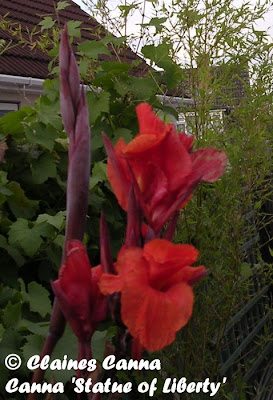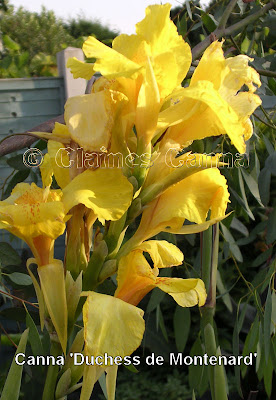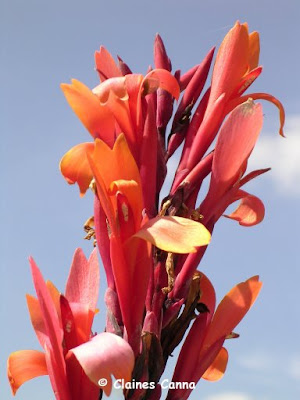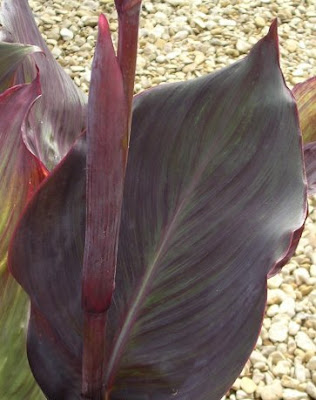Canna hybridizers have an extra interest in the preservation of the honey-bee, as the most prolific of pollinators in Northern Europe, and elsewhere.
Thursday, 31 July 2008
Fungus Foot Baths Could Save Bees
Wednesday, 30 July 2008
Ian Cooke recognised

Tuesday, 29 July 2008
Monday, 28 July 2008
Revisiting Canna 'Russian Lance'


Introduced by Malcolm Dalebö, Claines Canna Collection, Worcester, England, EU in 2003. Breeding is C. 'Russian Red' x open.
Sunday, 27 July 2008
Revisiting Canna 'Cleopatré'


Fades to a pink colour, luckily the fresh orange colour lasts for several days.
Saturday, 26 July 2008
Revisiting Canna 'Antonin Crozy'

The earliest reference is Garden & Forest, 28 August 1889. Writing in the Garden & Forest in 1896, Theophilus Hatfield wrote that "Canna 'Souvenir Antonin Crozy' remains the best of all the true Crozy type, and it is doubtful if any of this year's introductions will equal it in beauty."
Synonyms: C. 'Anthony Crozy', C. 'Anthony de Crozy', C. 'Antoine Crozy', C. 'Souvenir de Antoine Crozy'
Friday, 25 July 2008
Revisiting Canna 'American Flag'


Introduced by Antoine Wintzer of The Conard & Jones Co., West Grove, PA, USA in 1902.
Thursday, 24 July 2008
Revisiting Canna 'Statue of Liberty'

A tall Italian Group cultivar; purple foliage, oval shaped, upright habit; round stems, coloured purple; panicles of flowers are open, self-coloured carmine, staminodes are large, edges irregular, petals purple with farina, fully self-cleaning; seed is sterile, pollen is low fertile; rhizomes are thick, up to 3 cm in diameter, coloured purple; tillering is prolific.
Introduced by Antoine Wintzer of The Conard & Jones Co., West Grove, PA, USA.
The staminoides are very fine and thin, and when the sun shines through them there are colour transformations. The bloom only lasts for a day or so, but in that time it makes its statement.
Wednesday, 23 July 2008
Fungus disease rampaging through UK
Experts are alarmed by the speed of the infection, already found in 52 formal gardens in the South-West and Midlands.

It is a close relative of so-called 'Oak Disease' - Phytophthora ramorum - which devastated California's oak population and has already infected hundreds of Britain's trees and shrubs.
Burning of infected plants has so far failed to control the kernoviae fungus, which was discovered in Cornwall in 2003 and since rampaged across the country.
The spread of the related ramorum fungus, first detected in 2002, has seen almost 800 trees felled in sites across England and Wales, according to Defra.
The disease has recently reached beyond gardens and woodland for the first time, by infecting native Bilberry bushes on heathland in Cornwall.
Jeff Rooker, minister for Farming and Animal Health said: ''Despite five years of emergency action, Phytophthora kernoviae and Phytophthora ramorum have continued to spread in the nursery trade and wider envirnoment.
"We now know that they have the potential to cause significant harm to businesses and the natural landscape, and we need to decide on a policy for future management."
Phytophthoras are the same family of fungii whuch caused the Irish potato famine, and there are fears the disease could devastate rural industries.
The National Trust has seen 14 of its gardens infected, and is urgently creating a living archive of rare shrubs and plants which may not survive.
As the disease orginiated abroad, experts fear rare British plant species, which have no natural immunity to it, may be wiped out.
The exotic rhododendron ponticum, imported from Asia by the Victorians, is widely blamed for introducing the fungii to the UK.
But once it has taken root in an area, the disease can spread rapidly through new 'host' plants, which could include common garden trees and shrubs.
A Defra consultation paper published this month warned that healthland, woodland and other habitats could be under threat for decades if the fungus is not controlled.
Tuesday, 22 July 2008
Revisiting Canna 'Star of India'

Introduced by S. Percy-Lancaster, Alipore Cannas, Calcutta, India.
The earliest reference is by Sydney Percy-Lancaster, "An Amateur in an Indian Garden", 1927. In the collection of the Royal Agri-Horticultural Society , Alipore, Calcutta, India. Dr. Khoshoo & Dr. I. Guha: Evolution of Cultivated Canna, 1966.
Monday, 21 July 2008
Canna sales at Claines
 I was planning to follow up the two previous pollination articles with several articles relating to hand-pollination. However, that will have to wait a day or so, as other events have intervened.
I was planning to follow up the two previous pollination articles with several articles relating to hand-pollination. However, that will have to wait a day or so, as other events have intervened.As regular bloggers will be aware, last season we suffered a terrible growing year, where we had hardly any worthwhile light during the summer floods, and just enough in the late summer and Autumn (Fall) to start recovering. As a result we had bad foliage on almost every one of our Cannas. The symptoms of stress due to lack of light and Canna virus are identical, as the Canna has a limited vocabulary!
After talking this over, we came to the conclusion that we should not sell any rhizomes last winter, as we had no idea whether they had virus or not. We still went ahead and produced a catalogue of the Collection, but clearly stating that there would be no mail-order sales.
However, we also had the plants from last year that we knew were not affected by virus. These we planned to pot up and sell as growing plants this summer. Over the winter we cleaned and packed about 1,000 rhizomes of these plants. However, during bad weather the electricity supply was cut overnight, and we lost to frost nearly all of the rhizomes we had in our store.
As a result, we have nothing left to sell at present, and all we are left with is the stock plants of the collection, that we are still growing on. We hope that by August we should know what is affected by virus and which is clear, and therefore saleable in the future.
Sunday, 20 July 2008
Saturday, 19 July 2008
Friday, 18 July 2008
Revisiting Canna 'Pringle Bay'


A true dwarf canna, with attractive, delicate, pale pink flowers. However, its main attraction is the bright variegated foliage, green, bronze and pink.
Terence Bloch reputedly introduced it from South Africa and named it 'Pringle Bay', after where it originated from in that country. Somewhat mysteriously, the name 'Pink Sunburst' now seems to be the preferred name, but the International Code of Nomenclature for Cultivated Plants stipulates that this is simply a synonym of the original name.
Synonyms: C. 'African Sunset', C. 'Pink Sunburst', C. 'Technicolor'
Thursday, 17 July 2008
Revisiting Canna 'Dr. Nansen'

Wednesday, 16 July 2008
Revisit Canna 'Duchess de Montenard'

Introduced by A. Crozy, Lyon, France.
Tuesday, 15 July 2008
Revisiting Canna 'Valbonne'


Introduced by Vilmorin-Andrieux in 1941.
Monday, 14 July 2008
Q&A Why so many Cannas the same?
Why do some Cannas that look the same have different names?
Answer.
In the absence of a Canna Society or registry for hybridizers, many Canna cultivars have been claimed, renamed, and even patented by nurseries or companies that had nothing to do with developing that cultivar.
Some Canna are also very generous with producing "sports,"which are mutations that can be propagated and sold as a new variety. The classic example is Canna 'Yellow King Humbert', which has produced many new all purple foliage plants with red flowers. The same sport may occur spontaneously at different nurseries and each might claim it as a new introduction and give it their own name. This causes a lot of confusion for Canna enthusiasts!
Sunday, 13 July 2008
Revisiting Canna 'Kansas City'


Saturday, 12 July 2008
That's why there's no growth!
So, I looked back at the last months predictions, and by Jove it looks like Nick is right! Thank you for sharing that knowledge with us. Tonight is predicted at 8C, then onwards we have nightly temperatures averaging about 13C.
We have had very few nights so far here in Worcestershire where temperatures exceeded 10C. This is another factoid that needs to enter the ever-growing Canna virtual cyclopedia!
Friday, 11 July 2008
Why no growth?
However, we are now asking why we have experienced such little growth. A month after planting outside in well fertilized beds, we can see little new growth. The plants that were blazing away inside the polytunnel have gone on strike! A few have started new stems, and a few have produced some very weak flowers, but no real growth.
During the month of June we had some good days for sunlight, the watering was intensive, the plants have been dosed with seaweed fertilizer, both liquid and solid and they have had one dose of Miracle-Gro. Perhaps we have given the Cannas an environment that is too nutritious? Unheard of, this is a plant used in sewage schemes because of its ability to thrive in such circumstances and is renowned as a hungry feeder!
Thursday, 10 July 2008
Floods on their way again
 Parts of Britain were deluged by nearly a month's rainfall in just a few hours today as freak summer weather brought chaos across the country.
Parts of Britain were deluged by nearly a month's rainfall in just a few hours today as freak summer weather brought chaos across the country. Downpours sparked flood warnings nationwide as forecasters predicted nearly two inches of rain in the worst-affected areas.
South west England, the south west Midlands, where we live, and south east Wales are expected to suffer the heaviest rainfall, and flood warnings have also been issued in Devon.
The Environment Agency has warned that residents living near the Rivers Tamar, Torridge and Walden face likely flooding of their homes and businesses.
Other parts of south west England and the Thames region have been put on flood watch and warned to expect flooding of low-lying land and roads.
With weather experts warning that a summer monsoon season was now part of the UK weather pattern, it looks like it will become harder to grown tropical and sub-tropical plants in this climate. Plants need light, and weeks on end of rain means no sunlight during that period.
Let's try and be philosophical about this latest weather outrage... we don't have to do any watering!
Wednesday, 9 July 2008
Revisiting Canna 'Guttermanni'

A tall Foliage Group cultivar; dark foliage, oval shaped, branching habit; triangular stems, coloured purple; spikes of flowers are erect, self-coloured orange, staminodes are long and narrow, edges irregular, petals purple, fully self-cleaning; fertile both ways, not true to type, self-pollinating, capsules globose; rhizomes are thick, up to 3 cm in diameter, coloured pink and purple; tillering is average.

Synonym: C. 'Sparks'
Tuesday, 8 July 2008
English summer washout
 The English summer is heading for a total washout, with little chance of any long periods of sunshine. This follows bad weather at Wimbledon last week.
The English summer is heading for a total washout, with little chance of any long periods of sunshine. This follows bad weather at Wimbledon last week.Most of the country will be drenched by thundery showers all this week – and forecasters predict that could set the pattern for the rest of the month and beyond.
The miserable outlook even led one forecaster to warn that this summer could be among the wettest on record.
Jonathan Powell, of Positive Weather Solutions, is quoted as saying there was an “unsettled picture” for July and August. “Whereas we may have a few days of fine weather, there will be no lengthy spells of sunshine or sustained warm temperatures,” he said. “That is because, once again, Atlantic weather systems will continue to deliver wet, windy conditions and average temperatures.”
Dave Elliott at the Met Office agreed. “Rainfall is looking above average or similar to average for the rest of the summer, with the temperatures nearly average or a touch below,” he said. “Last year was a pretty bad summer as well – a lovely April and September but fairly unsettled in between.
“This year we’ve not had a prolonged warm, dry spell. We’ve had several nice days but not a couple of weeks at a time. You have to go back to 2006 for a glorious summer, hot, dry and sunny.”
So, what does that mean to Canna gardeners. I would suggest that you keep a reasonable spacing between your plants. I have always liked the jungle effect achieved when the foliage intertwines, but this year we should not risk any plant not getting whatever sunlight is available. My youngest daughter used to describe the intertwining as the plants kissing, and I feel bad about having to increase the spacing.
A regular feeding with Miracle-Gro will ensure that whenever light is available the Canna engine can fire on all cylinders and produce as much growth as is practical during a poor-light summer. Really, it is a case of not wasting any days of reasonable light, it takes light, water and nutrients to produce plant growth and so when light is available it pays to ensure that the other essentials are there in abundance.
Monday, 7 July 2008
Revisiting Canna 'Liervalii'

A tall Foliage Group cultivar; purple foliage, oblong shaped, maroon margin, spreading habit; round stems, coloured purple; spikes of flowers are erect, self-coloured orange-red, staminodes are long and narrow, edges irregular, fully self-cleaning, outstanding bloomer; fertile both ways, not true to type, self-pollinating, capsules globose; rhizomes are thick, up to 3 cm in diameter, coloured purple; tillering is prolific. Introduced by Lierval, rue de Villiers, au Thernes, France, EU. in 1860.
Synonym: C. 'Red Bird'
Sunday, 6 July 2008
Revisiting Canna 'Mystique'

 Awards: Canna Trial 2002, AGM after trial at Wisley 2002, submitted by Great Dixter.
Awards: Canna Trial 2002, AGM after trial at Wisley 2002, submitted by Great Dixter. Synonyms: C. 'Ibis', C. 'Old Red'
Saturday, 5 July 2008
Revisiting Canna 'Purpurea Floribunda'

Synonyms: C. indica 'Purpurea', C. 'Purpurea'

Introduced by A. Crozy, Lyon, France in 1887. The earliest recorded reference is the Wilhelm Pfitzer Catalogue of 1890.
This hybrid has been the sire/siress of many great foliage plants. If you want to discover the pleasures of creating new Canna foliage plants, then this one is a great starting point.
Friday, 4 July 2008
Revisiting Canna 'Rubra Perfecta'


Introduced by Théodore Année, Passy, France, EU in 1861.
Thursday, 3 July 2008
Revisiting Canna 'Rubra Superbissima'

Introduced by Théodore Année, Passy, France, EU in 1862.
Wednesday, 2 July 2008
Describe Cannas: Plant shape
- Upright - erect in carriage or posture.

- Branching - to stretch out in a semi-perpendicular manner, approximately 45 degree angle.

Tuesday, 1 July 2008
Revisit Canna 'Stuttgart'

A tall Foliage Group cultivar; green and white variegated foliage, oval shaped, upright habit; half-round stems, coloured green; spikes of flowers are erect, self-coloured apricot, staminodes are long and narrow, edges regular, fully self-cleaning; fertile both ways, not true to type, self-pollinating, capsules round; rhizomes are long and thin, coloured white; tillering is prolific. Introduced by Bob Hayes of the Brooklyn Botanic Garden, USA.

Has a synonym 'Striata', but this is patently not correct as that is a separate and distinct cultivar correctly named C. 'Bengal Tiger'.
The variegation is due to mutation in meristematic tissue of an otherwise normal plant. The mutation involved the loss of the chloroplasts in the mutated tissue, so that part of the plant tissue has no green pigment and no photosynthetic ability. This mutated tissue is unable to survive on its own but is kept alive by its partnership with the normal, photosynthesising tissue.





